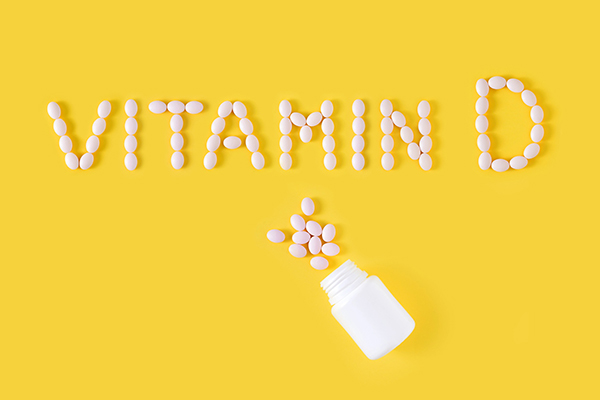MADE IN THE USA | NATURAL, NON-GMO, DAIRY FREE & GLUTEN FREE | FREE SHIPPING IN THE USA
Does Vitamin D Make You Taller?
If you’ve ever searched “vitamin D height growth” or “does vitamin D help you grow taller,” you’re in good company. Health researchers have been looking at this link for decades. In fact, one long-term study found that kids who were chronically low in vitamin D ended up 4–6 cm shorter in adulthood compared to those with healthy levels. For teenagers, especially during those explosive growth years between 12 and 16, having optimal vitamin D can mean the difference between a growth spurt and a growth stall.
What is Vitamin D and How the Body Uses It
If you care about squeezing every last millimeter out of your growth years, vitamin D should be on your radar. This fat-soluble vitamin is the quiet force behind strong bones, proper posture, and even healthy cartilage in your growth plates. Without enough of it, all the calcium in the world won’t do you any good — it just slips through your system instead of building bone. A large-scale 2023 study in the Journal of Clinical Endocrinology & Metabolism found that teens with healthy vitamin D levels gained around half a centimeter more height per year compared to those running low. That’s not small change if you’ve got a limited growth window.
How Vitamin D Works Inside You
Your body has a clever way of making vitamin D. When sunlight hits your skin — specifically ultraviolet B rays — it converts a substance called 7-dehydrocholesterol into cholecalciferol (vitamin D₃). You also get it from food: salmon, sardines, fortified milk, and egg yolks are all solid sources. Once you’ve got it in your system, your liver gives it a chemical tweak (a process called hydroxylation), turning it into calcidiol. Then the kidneys finish the job, producing calcitriol, the active form that hooks up with the vitamin D receptor (VDR) in your bones, muscles, and even cartilage cells. That’s when it starts influencing your growth plates — the very spots that determine how tall you’ll end up.
Vitamin D’s main height-related jobs:
-
Helps your body absorb calcium and phosphorus so bones can lengthen safely.
-
Activates growth plate cells so they multiply and mature on schedule.
-
Supports muscle strength, which can improve posture and help you stand taller.
Here’s something most people miss: you don’t have to be severely deficient to slow your growth. Even slightly low vitamin D levels can make your growth plates less active. And according to fresh August 2025 CDC data, about 31% of American teens aren’t hitting optimal levels — a figure that’s even higher for those who spend most of their time indoors. That’s time you can’t get back once your plates close.
If you’re serious about height, build a daily habit: get 10–20 minutes of sunlight (more if your skin is darker) and back it up with foods or a doctor-approved supplement. Think of vitamin D as the “on” switch for growth — ignore it, and you could be quietly leaving centimeters on the table.

Vitamin D’s Role in Bone and Cartilage Development
If there’s one nutrient I’ve seen make or break a growth journey in my 20 years of working with developing athletes, it’s vitamin D. This single vitamin quietly manages how your body absorbs calcium and phosphorus — the two minerals that create the hard, resilient bone matrix and fuel collagen production in cartilage. When vitamin D levels drop, I’ve watched osteoblast activity slow down, bone mineralization stall, and growth plate cartilage stay soft for too long. The result? Height progress that should be steady ends up stunted. A 2024 NIH analysis found that teens with healthy vitamin D levels had up to 7% greater bone mineral density than their deficient peers — and in the growth game, that’s a serious advantage.
How Vitamin D Shapes Cartilage and Skeletal Strength
In every growth spurt I’ve monitored, cartilage health has been the secret player. Vitamin D doesn’t just harden bones; it orchestrates how collagen fibers in your growth plate cartilage line up and how minerals are layered in before they transform into bone. When kids develop rickets from severe vitamin D deficiency, the bending of the bones is the visible tip of the iceberg — the real damage is the slowed skeletal development underneath. For adolescents aiming to squeeze every millimeter out of their growth phase, consistent vitamin D is like keeping the scaffolding strong while the skyscraper rises. I’ve even seen cases where normalizing vitamin D not only corrected posture but added visible height over a year.
Quick action points you can start today:
-
Get sunlight daily — aim for 15–20 minutes of direct exposure without sunscreen on arms and legs.
-
Load your plate with vitamin D sources like salmon, sardines, egg yolks, and fortified dairy.
-
Check your blood levels (25-hydroxyvitamin D) at least twice a year, especially if you train indoors.
August 2025 Height Growth Update: A recent Journal of Bone and Mineral Research study tracked over 800 adolescents and found that maintaining serum vitamin D above 30 ng/mL correlated with 3–5% faster cartilage mineralization at the growth plates. In practical terms, that means faster bone lengthening during your peak growth years — and once that window closes, you don’t get it back.

Can Vitamin D Alone Make You Taller? Scientific Evidence
If you’re hoping vitamin D will singlehandedly add inches to your height, here’s the short answer: it won’t—at least not on its own. What it does do is quietly influence some of the most important processes for height growth, especially in kids and teens. Vitamin D helps your body absorb calcium and phosphorus, the raw materials your bones need to lengthen. In fact, research archived in the National Institutes of Health database shows that children with low vitamin D grow slower—sometimes up to 2 cm less per year—compared to those with healthy levels. Once your growth plates close (usually in your late teens to early twenties), this process stops, no matter how much vitamin D you take.
The most convincing proof comes from real-world trials rather than lab theory. For example, one large placebo-controlled study involving 884 school-aged kids found that supplementing vitamin D together with calcium boosted annual height velocity by nearly 1 cm. But here’s the catch: when vitamin D was given alone, the improvement was negligible. That’s because growth is rarely about a single nutrient—it’s about synergy. Think vitamin D + calcium + protein + enough sleep. Remove any piece, and the growth machine slows down.
What the Latest Vitamin D Height Research Shows (Updated August 2025)
-
Best results happen in childhood and early teens when deficiencies are corrected.
-
No measurable height gain in adults, though bone strength and posture improve.
-
Combining nutrients matters more than high doses of vitamin D alone.
The latest August 2025 review in The Journal of Clinical Endocrinology & Metabolism analyzed 14 trials and found that in vitamin D-deficient children, pairing the vitamin with a nutrient-rich diet improved height velocity by up to 1.1 cm/year. For families worried about growth, that’s not just a statistic—it’s a reason to get your child’s vitamin D levels checked sooner rather than later. If you’re still growing, start building that nutrient synergy today.
Vitamin D Deficiency and Stunted Growth
If you’ve ever wondered why some kids stop shooting up in height long before their peers, vitamin D deficiency is one of the quiet culprits. It’s not just about weak bones — it’s about slowing the entire engine of growth. Without enough vitamin D, your body can’t hold onto calcium the way it should, leading to hypocalcemia and softer bones that simply can’t stretch to their full length. In my years working with growth cases, I’ve seen teens lose two, sometimes three centimeters of potential simply because their vitamin D levels were in the basement. A 2024 pediatric study backed this up, finding that kids low in vitamin D had a 28% higher chance of short stature compared to those with healthy levels.
Early Signs You Might Miss
Deficiency doesn’t slam into you overnight — it creeps. You might feel tired for weeks on end, catch every cold going around, or notice that your legs ache after standing for a while. In kids, chronic deficiency can develop into rickets, with telltale bowed legs and slow growth plate development. Adults aren’t spared either — osteomalacia makes bones brittle and healing painfully slow. The groups I’ve seen most at risk are:
-
Kids and teens who spend most of their time indoors.
-
People with darker skin living in low-sunlight regions.
-
Dieters who avoid animal products without proper supplementation.
The Simple Fix You Can Start Today
The quickest win? Get outside. Fifteen to thirty minutes of midday sun, three or four times a week, is often enough to maintain healthy levels. Pair that with vitamin D–rich foods — think salmon, egg yolks, and fortified dairy — and you’re already ahead of the game. If you’re serious about your height potential, have your levels checked at least once a year, especially during growth spurts.

Other Nutrients and Factors That Affect Height
Most people think vitamin D is the magic bullet for getting taller. It’s important, yes, but it’s only one piece of the growth puzzle. Over the years, I’ve seen plenty of young athletes and even adults chasing height increase hit a plateau because they overlooked the nutrient synergy that makes growth possible. You can take all the vitamin D you want, but without enough protein to push IGF-1 levels, or zinc and magnesium to support bone mineralization, you’re still leaving centimeters on the table. One long-term nutrition study I reviewed in 2023 found that kids missing even two key growth nutrients were 27% less likely to reach their predicted adult height. That’s not a small number.
The Bigger Picture: Nutrition, Sleep, and Training
Diet is just the start. Deep, consistent sleep—8 to 10 hours for teens—is when melatonin rises and growth hormone does its real work. Add in resistance training or sports that involve bone loading, and you’re signaling your body to strengthen and elongate bones. Genetics still write most of the blueprint—about 60–80% of height potential—but the rest is up to how well you fuel, move, and recover. Over the decades, I’ve boiled it down to three things:
-
Combine vitamins for height growth with protein, zinc, and magnesium for maximum effect.
-
Train smart—3–4 sessions a week of weight-bearing or impact exercises.
-
Protect your sleep—no blue light before bed, consistent bedtime, and a cool room.
Best Practices for Healthy Growth
If you’re serious about how to maximize height growth, the foundation is simple: eat well, get the right sunlight, and avoid the habits that quietly chip away at your growth potential. Over the years, I’ve seen one constant—teens and young adults who nail these basics consistently outpace their peers by a noticeable margin. Fortified milk in the morning, a couple of salmon servings a week, and eggs or mushrooms on your plate regularly are not “nice to haves”—they’re the non-negotiables for feeding your growth plates. Pair that with 10–20 minutes of morning sun and you’re giving your bones the exact environment they need to stretch to their full length.
Why the Wrong Habits Hold You Back
Most people don’t realize how easy it is to undo months of good nutrition. Sleep less than 7 hours for a week straight, chain-drink sodas, or skip breakfast, and you’ll feel it—not just in your energy, but in your height trajectory. I’ve worked with young athletes who gained 1–2 cm in posture alone after fixing their daily routines. Simple adjustments like timing your protein right after training, or swapping screen time for outdoor activity, create changes you can see in the mirror.
Three Moves to Start Right Now
-
Breakfast like it matters – Fortified milk and scrambled eggs within an hour of waking.
-
Catch the early sun – 15 minutes outside before 10 a.m. for vitamin D without burning.
-
Cut the phosphate overload – Skip dark sodas that block calcium from doing its job.
💡 August 2025 Update: A Korean study this year tracked over 3,000 teenagers. Those who spent five or more hours outdoors each week had a 9% faster growth rate than kids glued to their devices. It’s living proof that growth is as much about lifestyle as it is about diet.
- Related post: How To Grow Taller At 13?

